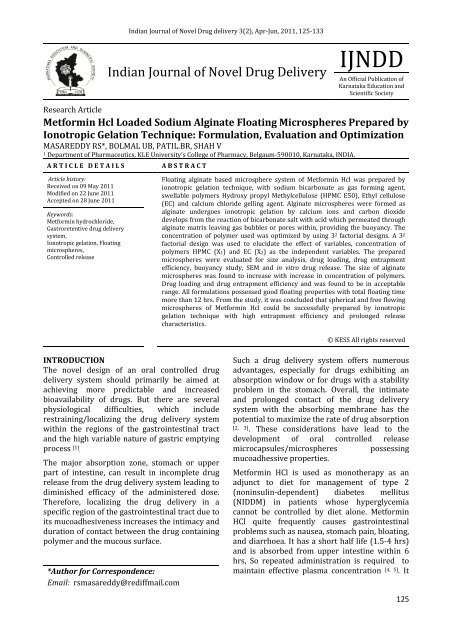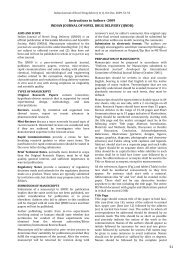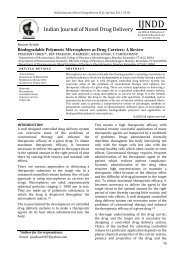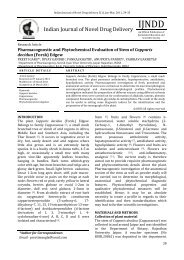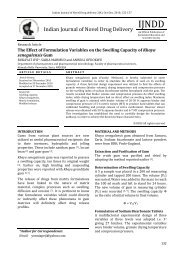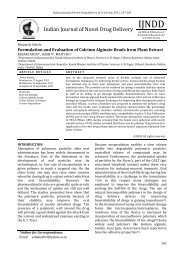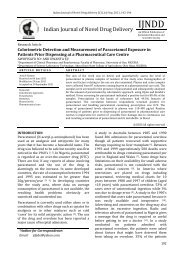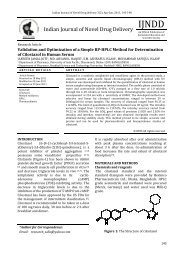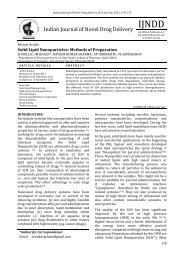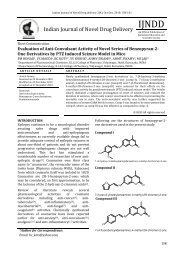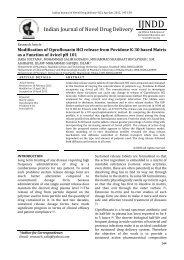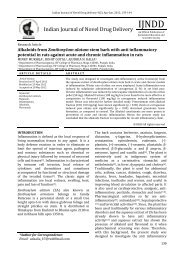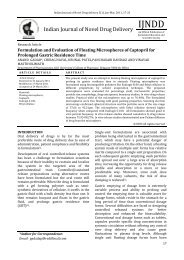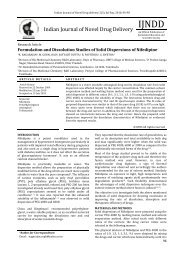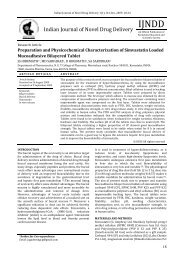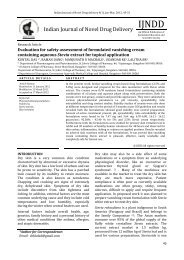Metformin Hcl Loaded Sodium Alginate Floating Microspheres ...
Metformin Hcl Loaded Sodium Alginate Floating Microspheres ...
Metformin Hcl Loaded Sodium Alginate Floating Microspheres ...
You also want an ePaper? Increase the reach of your titles
YUMPU automatically turns print PDFs into web optimized ePapers that Google loves.
Indian Journal of Novel Drug delivery 3(2), Apr-Jun, 2011, 125-133<br />
Indian Journal of Novel Drug Delivery<br />
IJNDD<br />
An Official Publication of<br />
Karnataka Education and<br />
Scientific Society<br />
Research Article<br />
<strong>Metformin</strong> <strong>Hcl</strong> <strong>Loaded</strong> <strong>Sodium</strong> <strong>Alginate</strong> <strong>Floating</strong> <strong>Microspheres</strong> Prepared by<br />
Ionotropic Gelation Technique: Formulation, Evaluation and Optimization<br />
MASAREDDY RS*, BOLMAL UB, PATIL.BR, SHAH V<br />
1 Department of Pharmaceutics, KLE University’s College of Pharmacy, Belgaum-590010, Karnataka, INDIA.<br />
A R T I C L E D E T A I L S<br />
A B S T R A C T<br />
Article history:<br />
Received on 09 May 2011<br />
Modified on 22 June 2011<br />
Accepted on 28 June 2011<br />
Keywords:<br />
<strong>Metformin</strong> hydrochloride,<br />
Gastroretentive drug delivery<br />
system,<br />
Ionotropic gelation, <strong>Floating</strong><br />
microspheres,<br />
Controlled release<br />
<strong>Floating</strong> alginate based microsphere system of <strong>Metformin</strong> <strong>Hcl</strong> was prepared by<br />
ionotropic gelation technique, with sodium bicarbonate as gas forming agent,<br />
swellable polymers Hydroxy propyl Methylcellulose (HPMC E50), Ethyl cellulose<br />
(EC) and calcium chloride gelling agent. <strong>Alginate</strong> microspheres were formed as<br />
alginate undergoes ionotropic gelation by calcium ions and carbon dioxide<br />
develops from the reaction of bicarbonate salt with acid which permeated through<br />
alginate matrix leaving gas bubbles or pores within, providing the buoyancy. The<br />
concentration of polymer used was optimized by using 3 2 factorial designs. A 3 2<br />
factorial design was used to elucidate the effect of variables, concentration of<br />
polymers HPMC (X1) and EC (X2) as the independent variables. The prepared<br />
microspheres were evaluated for size analysis, drug loading, drug entrapment<br />
efficiency, buoyancy study, SEM and in vitro drug release. The size of alginate<br />
microspheres was found to increase with increase in concentration of polymers.<br />
Drug loading and drug entrapment efficiency and was found to be in acceptable<br />
range. All formulations possessed good floating properties with total floating time<br />
more than 12 hrs. From the study, it was concluded that spherical and free flowing<br />
microspheres of <strong>Metformin</strong> <strong>Hcl</strong> could be successfully prepared by ionotropic<br />
gelation technique with high entrapment efficiency and prolonged release<br />
characteristics.<br />
© KESS All rights reserved<br />
INTRODUCTION<br />
The novel design of an oral controlled drug<br />
delivery system should primarily be aimed at<br />
achieving more predictable and increased<br />
bioavailability of drugs. But there are several<br />
physiological difficulties, which include<br />
restraining/localizing the drug delivery system<br />
within the regions of the gastrointestinal tract<br />
and the high variable nature of gastric emptying<br />
process [1] .<br />
The major absorption zone, stomach or upper<br />
part of intestine, can result in incomplete drug<br />
release from the drug delivery system leading to<br />
diminished efficacy of the administered dose.<br />
Therefore, localizing the drug delivery in a<br />
specific region of the gastrointestinal tract due to<br />
its mucoadhesiveness increases the intimacy and<br />
duration of contact between the drug containing<br />
polymer and the mucous surface.<br />
*Author for Correspondence:<br />
Email: rsmasareddy@rediffmail.com<br />
Such a drug delivery system offers numerous<br />
advantages, especially for drugs exhibiting an<br />
absorption window or for drugs with a stability<br />
problem in the stomach. Overall, the intimate<br />
and prolonged contact of the drug delivery<br />
system with the absorbing membrane has the<br />
potential to maximize the rate of drug absorption<br />
[2, 3]. These considerations have lead to the<br />
development of oral controlled release<br />
microcapsules/microspheres possessing<br />
mucoadhessive properties.<br />
<strong>Metformin</strong> HCl is used as monotherapy as an<br />
adjunct to diet for management of type 2<br />
(noninsulin-dependent) diabetes mellitus<br />
(NIDDM) in patients whose hyperglycemia<br />
cannot be controlled by diet alone. <strong>Metformin</strong><br />
HCl quite frequently causes gastrointestinal<br />
problems such as nausea, stomach pain, bloating,<br />
and diarrhoea. It has a short half life (1.5-4 hrs)<br />
and is absorbed from upper intestine within 6<br />
hrs, So repeated administration is required to<br />
maintain effective plasma concentration [4, 5] . It<br />
125
Masareddy RS et al / Indian Journal of Novel Drug Delivery 3(2), Apr-Jun, 2011, 125-133<br />
may therefore be more desirable to deliver the<br />
drug in a sustained release dosage form.<br />
Factorial design is an efficient tool to obtain an<br />
appropriate mathematical model with minimum<br />
experiments for optimization of formulation<br />
design. Studies based on factorial design allow all<br />
the factors to be varied simultanously, thus<br />
enabling the evaluation of the effects of each<br />
variable at each level and showing<br />
interrelationship among them. The most<br />
important variables which affect the system<br />
function are selected and systemic experiments<br />
are then performed to the specified factorial<br />
design. The number of independent variables<br />
selected decides the number of experiments that<br />
are to be performed [6] .<br />
The objective of the present study was to<br />
develop alginate mucoadhesive microcapsules<br />
for sustained release of <strong>Metformin</strong> <strong>Hcl</strong> by ionic<br />
gelation technique, using Hydroxy propyl methyl<br />
cellulose (HPMC) as mucoadhesive polymer and<br />
ethyl cellulose (EC) as rate controlling polymer.<br />
A 3 2 full factorial design was employed to<br />
evaluate the effect of each of the selected<br />
variables and their interactions on the response.<br />
MATERIALS AND METHODS<br />
<strong>Metformin</strong> HCl was obtained as a gift sample<br />
from Zydus Cadila healthcare ltd., Ahmedabad,<br />
HPMC K4M was generously supplied by Dow<br />
Chemicals. Ethyl cellulose was gifted by Hi’media<br />
Ltd., <strong>Sodium</strong> alginate, Calcium chloride; Barium<br />
chloride and sodium bicarbonate were procured<br />
from S. D. Fine Chemicals Ltd., Mumbai.<br />
Formulation of floating microspheres of<br />
<strong>Metformin</strong> <strong>Hcl</strong> [7, 8]<br />
<strong>Floating</strong> alginate microspheres of <strong>Metformin</strong> <strong>Hcl</strong><br />
were prepared by ionotropic gelation technique<br />
using different proportion of polymers as shown<br />
in Table 1. A 3% w/v solution of sodium alginate<br />
solution was added to weighed amount of ethyl<br />
cellulose dissolved in required quantity of<br />
ethanol.<br />
Weighed quantity of drug and HPMC E50 was<br />
triturated to form fine powder, then added to<br />
above solution. <strong>Sodium</strong> bicarbonate, a gasforming<br />
agent was added to this mixture and the<br />
resulting solution was stirred uniformly. Using a<br />
26 G syringe needle the above solution was<br />
dropped into 100 ml of gently agitated calcium<br />
chloride (3% w/v) solution to obtain<br />
microspheres. The solution containing<br />
microsphere was stirred slowly using magnetic<br />
bead for about 10 min. The microspheres were<br />
further allowed to remain in the same solution<br />
for 20 min to improve mechanical strength. The<br />
formed microspheres were filtered, washed with<br />
distilled water, air-dried at room temperature<br />
and stored in desiccators.<br />
Optimization of <strong>Floating</strong> microspheres of<br />
<strong>Metformin</strong> HCl [8, 9]<br />
A 3 2 randomized full factorial design was utilized<br />
in the present study. In this design two factors<br />
were evaluated, each at three levels and<br />
experimental trials were carried for all nine<br />
possible combinations. The factors were selected<br />
based on preliminary study. The concentration of<br />
HPMC (X 1) and concentration of Ethyl cellulose<br />
(X 2) were selected as independent variables. The<br />
% drug release at 2, 6 and 10 th hours were Q 2, Q 6<br />
and Q 10 respectively selected as dependent<br />
variables.<br />
A statistical model incorporating interactive and<br />
polynomial terms was used to evaluate the<br />
responses. The number of experiments required<br />
for these studies is dependent on the number of<br />
independent variables selected. The response<br />
(Y i) is measured for each trial.<br />
Y = b 0 + b 1X 1 + b 2X 2 + b 12X 1X 2 + b 11X 1<br />
2 + b 22X 2<br />
2<br />
Where,<br />
Y is the dependent variable,<br />
b 0 is the arithmetic mean response of the nine<br />
runs and<br />
b 1 is the estimated coefficient for the factor X 1.<br />
The main effects (X1 and X 2) represent the<br />
average result of changing one factor at a time<br />
from its low to high value. The interaction terms<br />
(X 1X 2) show how the response changes when two<br />
factors are simultaneously changed.<br />
IR Study [10]<br />
IR study was performed to study compatibility<br />
between drug and polymer. The IR spectrum of<br />
pure <strong>Metformin</strong> <strong>Hcl</strong> and drug loaded alginate<br />
beads were obtained using KBr disk method<br />
subjected to FTIR with a Tensor 27. The samples<br />
were analyzed between wave numbers 4000 and<br />
600 cm-1 .<br />
Characterization of microspheres<br />
Microsphere size determination [7]<br />
Microsphere size was determined using an<br />
optical microscope under regular polarized light.<br />
The mean microsphere size was calculated by<br />
measuring 100 particles with the help of a<br />
calibrated ocular micrometer.<br />
126
Masareddy RS et al / Indian Journal of Novel Drug Delivery 3(2), Apr-Jun, 2011, 125-133<br />
Table 1: Composition of <strong>Metformin</strong> HCl microsphere formulation<br />
Formulation Code <strong>Metformin</strong> HCl (mg) HPMC E 50 (mg) Ethyl Cellulose (mg) <strong>Sodium</strong> Bicarbonate (mg)<br />
F1 500 100 100 100<br />
F2 500 100 50 100<br />
F3 500 100 150 100<br />
F4 500 50 100 100<br />
F5 500 50 50 100<br />
F6 500 50 150 100<br />
F7 500 150 100 100<br />
F8 500 150 50 100<br />
F9 500 150 150 100<br />
Table 2: Micromeritic parameters of formulated floating microspheres<br />
Formulation<br />
Code<br />
Average<br />
particle<br />
size (µm)<br />
Bulk<br />
density<br />
(g/cm 3 )<br />
Tapped<br />
density<br />
(g/cm 3 )<br />
Carr’s<br />
Index<br />
(%)<br />
Hausner’s<br />
Ratio<br />
Angle of<br />
repose (θ)<br />
F1 646.75 ± 11.14 0.403 ± 0.03 0.469 ± 0.01 14.19 ± 2.1 1.14 ± 0.03 25°20΄<br />
F2 583.32 ± 15.82 0.341 ± 0.03 0.401 ± 0.02 15.04 ± 2.3 1.17 ± 0.03 21°25΄<br />
F3 700.56 ± 9.55 0.440 ± 0.03 0.521 ± 0.04 15.47 ± 1.1 1.18 ± 0.02 27°89΄<br />
F4 646.75 ± 11.14 0.400 ± 0.02 0.468 ± 0.02 14.53 ± 2.7 1.16 ± 0.03 23°96΄<br />
F5 576.60 ± 11.09 0.318± 0.03 0.364 ± 0.04 12.32 ± 1.6 1.13 ± 0.02 20°22΄<br />
F6 681.34 ± 8.41 0.412 ± 0.01 0.486 ± 0.02 15.07 ± 0.5 1.17 ± 0.01 27°75΄<br />
F7 651.55 ± 13.43 0.405 ± 0.03 0.467 ± 0.03 13.39 ± 2.1 1.15 ± 0.02 26°56΄<br />
F8 595.82 ± 9.11 0.352 ± 0.02 0.410 ± 0.03 14.06 ± 0.9 1.16 ± 0.01 21°80΄<br />
F9 730.36 ± 10.33 0.457 ± 0.04 0.531 ± 0.06 13.99 ± 1.3 1.16 ± 0.02 29°35΄<br />
Table 3: Percent Yield, Drug Entrapment Efficiency, Drug Loading, Percent Buoyancy, and Percent<br />
Cumulative Drug Release<br />
Formulation<br />
Code<br />
Percent<br />
Yield<br />
% Drug<br />
Entrapment<br />
Efficiency<br />
% Drug Loading Percent<br />
Buoyancy<br />
F1 80.57 62.82 ± 0.49 33.05 ± 0.25 82.67 71.25<br />
F2 84.47 70.24 ± 0.24 39.01 ± 0.12 84.67 82.92<br />
F3 78.05 58.29 ± 0.42 28.91 ± 0.20 75.48 66.14<br />
F4 85.55 75.33 ± 0.14 41.93 ± 0.15 86.90 77.95<br />
F5 90.29 68.41 ± 0.49 40.21 ± 0.29 88.17 85.17<br />
F6 81.05 60.99 ± 0.26 32.05 ± 0.15 77.87 70.78<br />
F7 85.14 56.39 ± 0.28 28.17 ± 0.12 79.33 68.80<br />
F8 83.24 69.00 ± 0.40 36.28 ± 0.20 80.88 73.12<br />
F9 80.95 56.60 ± 0.29 26.91 ± 0.12 73.50 62.39<br />
Percent Cumulative<br />
Drug Release<br />
(12 hrs)<br />
Table 4: Summary of regression analysis for all microsphere formulations<br />
Coefficients b0 b1 b2 b12 b11 b22 R 2<br />
Q2 28.98 -1.596 -0.841 0.452 -5.4 -6.585 0.9765<br />
Q6 48.853 -3.976 -2.935 0.33 -3.78 -9.645 0.9241<br />
Q10 65.921 -3.401 -3.191 0.697 -5.798 -11.128 0.9825<br />
127
Masareddy RS et al / Indian Journal of Novel Drug Delivery 3(2), Apr-Jun, 2011, 125-133<br />
Morphological study using SEM [11]<br />
The morphological study analysis was performed<br />
using Scanning Electron Microscope (SEM). The<br />
surface topography and cross section of<br />
optimized microsphere formulation was scanned<br />
and examined under Electron Microscope JEOL<br />
JSM 6360, Japan. The sample was loaded on to a<br />
copper sample holder and sputter coated with<br />
carbon followed by gold.<br />
Micromeritics properties [12]<br />
Angle of repose (θ)<br />
The angle of repose of each powder blend was<br />
determined by glass funnel method, using<br />
following equation:<br />
θ = tan -1 h/r<br />
Where,<br />
θ = angle of repose<br />
h = height of the pile and<br />
r = radius of the powder cone<br />
Bulk density<br />
Bulk density of formulated microspheres was<br />
determined by taking a known mass of<br />
microspheres in a 5 ml graduated measuring<br />
cylinder. The cylinder was dropped three times<br />
from a height of one inch at an interval of two<br />
seconds. The bulk density was calculated by<br />
following equation.<br />
Weight of microsphere in grams<br />
Bulk density =<br />
Bulk volume of microsphere in cm 3<br />
Tapped density<br />
Tapped density is the volume of powder<br />
determined by tapping using measuring cylinder<br />
containing weighed amount of sample. Tapped<br />
density of microspheres was calculated by<br />
following equation.<br />
Mass of microspheres<br />
Tapped density =<br />
Volume of microspheres after tapping<br />
Carr’s compressibility index<br />
This is an important property in maintaining<br />
uniform weight. It is calculated using following<br />
equation,<br />
% Compressibility Index =<br />
Tapped density – Bulk density X 100<br />
Tapped density<br />
Hausner’s ratio<br />
Hausner’s ratio can be calculated by formula,<br />
Tapped Density<br />
Hausner’s Ratio = X 100<br />
Bulk Density<br />
Percentage Yield [13]<br />
The prepared microspheres of all batches were<br />
accurately weighed. The measured weight of<br />
prepared microspheres was divided by total<br />
amount of all the excipients and drug used in<br />
preparation of the microspheres, which give the<br />
total percentage yield of floating microspheres. It<br />
was calculated by using following equation.<br />
Actual Weight of product<br />
PY (%) =<br />
Total Weight of Excipients and Drug<br />
Drug Loading and entrapment efficiency [7, 14] :<br />
<strong>Microspheres</strong> (equivalent to 50 mg of the drug)<br />
were taken for evaluation. The amount of drug<br />
loaded and entrapped efficiency was estimated<br />
by crushing the microspheres and extracting<br />
with aliquots of 0.1 N <strong>Hcl</strong>, repeatedly. The extract<br />
was diluted to 100 ml in a volumetric flask using<br />
0.1 N <strong>Hcl</strong>. The solution was filtered and the<br />
absorbance measured at 237 nm against<br />
appropriate blank.<br />
The drug loading in microspheres was estimated<br />
using following formula,<br />
W D<br />
DL (%) = X 100<br />
W T<br />
Where,<br />
DL = Drug loading,<br />
W D = the total weight of the drug loaded in the<br />
microspheres<br />
W T = the total weight of the microspheres.<br />
W A<br />
EE (%) = X 100<br />
W T<br />
Where,<br />
EE = Entrapment Efficiency,<br />
W A = Actual drug content and<br />
W T = Theoretical drug content<br />
Percentage Buoyancy [11, 15]<br />
<strong>Microspheres</strong> (0.3g) were spread over the<br />
surface of a USP XXIV dissolution apparatus<br />
(type II) filled with 900 ml 0.1 N <strong>Hcl</strong>. The<br />
medium was agitated with a paddle rotating at<br />
128
Masareddy RS et al / Indian Journal of Novel Drug Delivery 3(2), Apr-Jun, 2011, 125-133<br />
100 rpm for 12 hrs. The floating and the settled<br />
portion of microspheres were recovered<br />
separately. The microspheres were dried and<br />
weighed. Buoyancy percentage was calculated as<br />
the ratio of the mass of the microspheres that<br />
remained floating and the total mass of the<br />
microspheres.<br />
% <strong>Floating</strong> <strong>Microspheres</strong> =<br />
Weight of floating microspheres at time t X 100<br />
Initial weight of microspheres<br />
In vitro drug release studies [16]<br />
The in vitro dissolution studies were carried<br />
using USP XXIV paddle type dissolution<br />
apparatus. Weighed amount of drug loaded<br />
floating microspheres were introduced into 900<br />
ml dissolution medium of pH 1.2 maintained at<br />
37±0.5 °C at a rotation speed of 100 rpm. 2 ml of<br />
aliquots were withdrawn at predetermined time<br />
intervals and an equivalent volume of fresh<br />
medium was replaced to maintain sink condition.<br />
The samples were analyzed<br />
spectrophotometrically at 237 nm to determine<br />
the concentration of drug present.<br />
Release Kinetics [17]<br />
To analyse the mechanism for the release and<br />
release rate kinetics of the dosage form, the data<br />
obtained was fitted into, Zero order, First order,<br />
Higuchi matrix, and Peppas model. The ‘r’ values<br />
obtained were compared to judge the best fit<br />
model.<br />
RESULT AND DISCUSSION<br />
The IR spectra of pure <strong>Metformin</strong> <strong>Hcl</strong> and drug<br />
loaded alginate beads, shown in the Fig.1, in<br />
which no significant shift in the peaks were<br />
observed, indicating the stability of the drug<br />
during encapsulation process.<br />
Micromeritic studies reveal that the prepared<br />
microspheres were faint brown, discrete,<br />
spherical and compact. Mean particles size of<br />
formulated microspheres was found to be in the<br />
range of 576.60±11.09 to 730.36±10.33 µm. The<br />
mean particle size of microsphere was found to<br />
increase with the polymer concentration, due to<br />
increase in viscosity of the polymer solution<br />
which increased the droplet size. The value of<br />
angle of repose determined ranges between 20º<br />
to 29º, bulk density and tapped density of<br />
formulated microspheres was found to be in<br />
range of 0.318±0.03 to 0.457±0.04 and<br />
0.364±0.04 to 0.531±0.06 respectively. The<br />
Carr’s index and Hausner’s ratio was found to be<br />
in range of 12 to 16, 1.13±0.02 to 1.18±0.02<br />
respectively .Upon considering the micromeritic<br />
properties of all formulations, F5 showed the<br />
best flow properties and compressibility, as<br />
indicated by angle of repose (20º22’), lowest<br />
Carr’s index (12.32±1.6), and Hausner’s ratio<br />
(1.13±0.02) suitable for formulation of solid<br />
dosage form. Results tabulated in Table 2.<br />
The scanning electron microscope images of<br />
microsphere illustrate spherical shape with thin<br />
and incomplete calcium surface coat with porous<br />
nature and rough texture as shown in the Fig.2.<br />
The porous structure may be due to rapid escape<br />
of the carbon dioxide during formulation. Inward<br />
dents observed in formulation indicate collapse<br />
of the walls of the microspheres during the in<br />
situ drying process.<br />
It was found that the average percentage yield<br />
was greater than 80 % for all formulations. The<br />
drug loading was found to be in range of 26.91 to<br />
41.93 %. Formulation F4 showed highest loading<br />
of 41.93 % while lowest drug loading of 26.91 %<br />
was observed in formulation F9. Overall the drug<br />
loading was found to decrease with increase in<br />
the polymer concentration due to its higher<br />
viscosity which affects the diffusion coefficient of<br />
drug. Drug entrapment was attributed to the<br />
permeation characteristics of polymers used,<br />
that could facilitate the diffusion of part of<br />
entrapped drug to the surrounding medium<br />
during preparation of floating microspheres.<br />
Depending upon the drug to polymer ratio the<br />
drug entrapment was found in the range of 56.60<br />
to 75.33%. The drug loading was found to<br />
decrease with increase in polymer concentration<br />
due to its higher viscosity which affects the<br />
diffusion coefficient of drug. In vitro buoyancy<br />
studies reveal that in spite of stirring the<br />
dissolution medium for more than 12 hours<br />
about 73 to 88% microspheres of batches F1 to<br />
F9 still continued to float without any apparent<br />
gelation. This indicates that the microspheres<br />
exhibit excellent buoyancy which may be<br />
attributed to the pores and cavities present in<br />
them. Formulation F9 showed least percentage<br />
buoyancy of 73.50 %, while F5 showed highest<br />
buoyancy of 88.17 % attributed to the relative<br />
density of microspheres in higher polymer<br />
concentrations. In vitro drug release studies it<br />
was found that with increase in concentration of<br />
HPMC E50 and Ethyl cellulose the drug release<br />
decreases. The increased density of the polymer<br />
matrix at higher concentration results in an<br />
increased diffusional path length. This may<br />
decrease the drug release from the polymer<br />
matrix.<br />
129
Masareddy RS et al / Indian Journal of Novel Drug Delivery 3(2), Apr-Jun, 2011, 125-133<br />
Figure 1: (A) IR spectra of pure <strong>Metformin</strong> HCl, (B) IR spectra of optimized formulation<br />
(A)<br />
(B)<br />
(C)<br />
(D)<br />
Figure 2: (A) Surface Topography (3000 X), (B) Surface Topography (1000 X), (C) Spherical and<br />
Rough, (D) Rough and Porous nature<br />
130
Masareddy RS et al / Indian Journal of Novel Drug Delivery 3(2), Apr-Jun, 2011, 125-133<br />
The in vitro release profile obtained indicated a<br />
biphasic pattern with initial burst effect followed<br />
by polymer controlled slower release. From the<br />
value of r obtained, all formulation follow the<br />
Higuchi matrix model which is diffusion<br />
controlled. Results tabulated in Table 3.<br />
The result of regression analysis showed that all<br />
the co-efficients bear a different sign, which<br />
indicated that both the polymers show different<br />
effect on the release of drug. Drug release at 2 nd h<br />
(Q 2) gives correlation co-efficient 0.9765. The P<br />
value for variable X 1 and X 2 were 0.0970 and<br />
0.2973 respectively (P
Masareddy RS et al / Indian Journal of Novel Drug Delivery 3(2), Apr-Jun, 2011, 125-133<br />
Figure 5: In vitro Drug release at 10 hrs<br />
CONCLUSION<br />
<strong>Metformin</strong> <strong>Hcl</strong> loaded alginate microspheres<br />
were successfully prepared by inotropic gelation<br />
method for use in floating drug delivery system.<br />
Concentration of polymer ratio influenced drug<br />
loading, entrapment efficiency, buoyancy and<br />
drug release profile of microspheres. A<br />
systematic study using a 3 2 factorial design<br />
helped in optimizing the suitable polymer<br />
concentration for desired drug release.<br />
ACKNOWLEGMENT<br />
The authors acknowledge KLE University’s<br />
College of Pharmacy, Belgaum; for providing the<br />
necessary support.<br />
REFERENCES<br />
[1] Rouge N, Buri P, Doelker E. Drug<br />
absorption sites in the gastrointestinal<br />
tract and dosage forms for site-specific<br />
delivery. Int. J. Pharm. 1996;136:117-39.<br />
[2] Chowdary KPR, Srinivasa Rao Y.<br />
Preparation and Evaluation of<br />
Mucoadhesive Microcapsules of<br />
Indomethacin. Indian J. Pharm. Sci.<br />
2003;65(1): 49-52.<br />
[3] Pothal RK, Sahoo SK, Chatterjee S, Sahoo<br />
D,Barik BB. Preparation and Evaluation of<br />
Mucoadhesive Microcapsules of<br />
Theophylline. The Indian Pharmacist.<br />
2004;3(28):74-79.<br />
[4] Indian Pharmacopoeia, Government of<br />
India Ministry of Health and Social Welfare.<br />
The Controller of Publications, Delhi,<br />
1996;Vol.I:469-70.<br />
[5] Murugesh N. “Oral antidiabetic drugs” In: A<br />
concise textbook of pharmacology, 5 th<br />
Edition, Sathya Publishers, Madurai,<br />
2003:196-7.<br />
[6] Dehghan S, Aboofazeli R, Avadi M, Khaksar<br />
R. Formulation, optimization of Nifedipine<br />
containing microspheres using factorial<br />
design. African Journal of Pharmacy and<br />
Pharmacology. June 2010;4(6):346-54.<br />
[7] Ninan Ma, Lu Xu, et al. Development and<br />
evaluation of new sustained-release<br />
floating microspheres. Int J Pharm<br />
2008;358:82-90.<br />
[8] Sahoo SK, Dalai SR, et al. Formulation and<br />
In vivo evaluation of alginate beads of<br />
Aceclofenac by ionotropic gelation<br />
technique. Indian Drugs 2007; 44(11):843-<br />
7.<br />
[9] Gosh A, Nath LK, Dey BK and Roy Partha. A<br />
study on the effect of different polymers on<br />
Frusemide loaded calcium alginate<br />
micropellets prepared by Ionotropic<br />
gelation technique. Indian J Pharm Edu Res.<br />
2007;41(4):329-36.<br />
[10] Swamy PV, Hada A, Shirsand SB,Hiremath<br />
SN and Raju SA. Preparation and in vitro<br />
evaluation of mucoadhesive microcapsules<br />
of Atenolol. Indian J Pharm Edu Res 2007;<br />
41(4):358-4.<br />
[11] Shrivastav A, Ridhurkar D, Wadhwa A.<br />
<strong>Floating</strong> microspheres of Cimetidine:<br />
Formulation, characterization and in vitro<br />
evaluation. Acta Pharm 2005;55:277- 285.<br />
[12] Parul Trivedi, AML Verma, N Garud.<br />
Preparation and characterization of<br />
Aceclofenac Microsphere. Asian Journal of<br />
Pharmaceutics. April 2008:110-5.<br />
[13] Nadigoti J, Shayeda. <strong>Floating</strong> drug delivery<br />
systems. Int J of Pharm Sci and<br />
Nanotechnology 2009;2(3):595-602.<br />
[14] M.K. Deepa, M. Karthikeyan. Cefpodoxime<br />
Proxetil <strong>Floating</strong> <strong>Microspheres</strong>:<br />
Formulation and In vitro Evaluation.<br />
Iranian Journal of Pharmaceutical<br />
Sciences.2009: 5(2):69-72.<br />
[15] Sanjay S. Patel, S. Ray and R. S. Thakur,<br />
Formualtion and Evaluation of <strong>Floating</strong><br />
132
Masareddy RS et al / Indian Journal of Novel Drug Delivery 3(2), Apr-Jun, 2011, 125-133<br />
Drug Delivery System containing<br />
Clarithromycin for Helicobacter Pylori,<br />
Acta Poloniae Pharmaceutica - Drug<br />
Research. 2006; 63(1):53-61.<br />
[16] Shashikant D. Barhate, Yogesh S. Rupnar,<br />
Rupesh M. Sonvane. Formulation and<br />
Evaluation of <strong>Floating</strong> <strong>Microspheres</strong> of<br />
Ketorolac Trometamol. International<br />
Journal of Pharma Research and<br />
Development .2009;1(9):1-8.<br />
[17] Costa P, Lobo JMS. Modeling and<br />
comparison of dissolution profiles. Eur J<br />
Pharm Sci 2001; 13: 123-33.<br />
133


